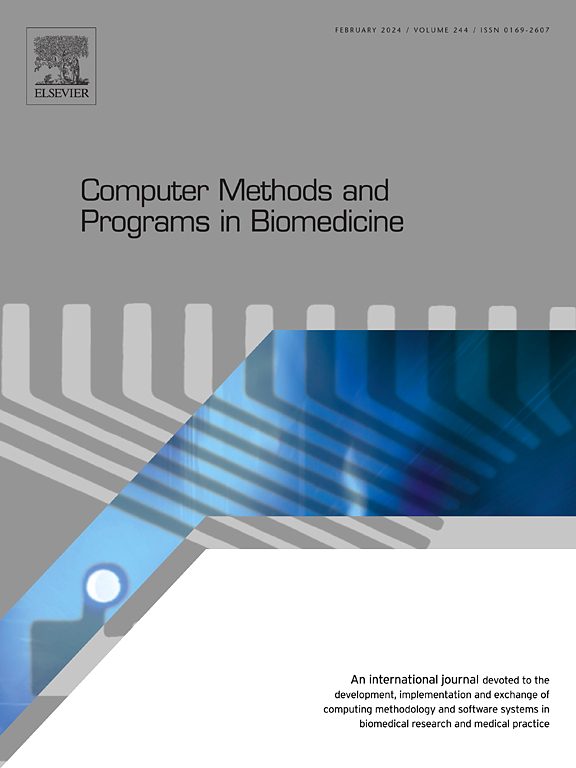基于时间卷积神经网络的心音图心脏异常特征提取与异步信道信息融合方法
IF 4.8
2区 医学
Q1 COMPUTER SCIENCE, INTERDISCIPLINARY APPLICATIONS
引用次数: 0
摘要
背景与目的基于听诊的心脏异常检测是儿科人群中有价值的筛查方法,特别是在资源有限的地区。然而,其临床应用往往受到心音图(PCG)信号变异性和难以区分病理性和无害性杂音的限制。方法提出了一种基于时间卷积网络(TCN)的特征提取和信息融合的框架,对患者层面异步采集的PCG记录进行整合。首先使用基于tcn的模型从分割的PCG信号中提取病理状态的概率表示。这些段级表征随后被平均以生成记录级或患者级特征。该框架旨在适应不同持续时间和不同听诊位置的记录。此外,我们通过结合迁移学习技术解决了心脏异常检测中的领域适应挑战。结果使用两个大型、独立的公共PCG数据集对所提出的方法进行了评估,在记录和患者水平上都显示出稳健的性能。虽然迁移学习在未见过的外部数据集上的初始性能不高,可能是由于人口统计学特征和信号采集的原因,但迁移学习显著提高了模型的性能,在外部验证中,在接收者操作特征曲线下的面积为0.931±0.027,在精确召回率曲线下的面积为0.867±0.064。结合内部和外部数据集,进一步增强了模型的泛化能力。该框架可容纳多通道、可变长度的PCG记录,使其成为检测儿童心脏异常的灵活、准确的解决方案,特别是在资源匮乏的环境中。源代码可以在Github上公开获得(https://github.com/baporlab/pcg_pathological_murmur_detection)。本文章由计算机程序翻译,如有差异,请以英文原文为准。
Temporal convolutional neural network-based feature extraction and asynchronous channel information fusion method for heart abnormality detection in phonocardiograms
Background and Objective
Auscultation-based cardiac abnormality detection is valuable screening approach in pediatric populations, particularly in resource-limited settings. However, its clinical utility is often limited by phonocardiogram (PCG) signal variability and a difficulty in distinguishing between pathological and innocent murmurs.
Methods
We proposed a framework that leverages temporal convolutional network (TCN)-based feature extraction and information fusion to integrate asynchronously acquired PCG recordings at the patient level. A probabilistic representation of the pathological state was first extracted from segmented PCG signals using a TCN-based model. These segment-level representations were subsequently averaged to generate record- or patient-level features. The framework was designed to accommodate recordings of varying durations and different auscultation locations. Furthermore, we addressed domain adaptation challenges in cardiac abnormality detection by incorporating transfer learning techniques.
Results
The proposed method was evaluated using two large, independent public PCG datasets, demonstrating robust performance at both record and patient levels. While its initial performance on an unseen external dataset was modest, likely due to demographic characteristics and signal acquisition, transfer learning significantly improved the model's performance, yielding an area under the receiver operating characteristic curve of 0.931±0.027 and an area under the precision-recall curve of 0.867±0.064 in external validation. Combining internal and external datasets further enhanced model generalizability.
Conclusion
This proposed framework accommodates multi-channel, variable-length PCG recordings, making it a flexible and accurate solution for detecting pediatric cardiac abnormalities, particularly in low-resource settings. The source code is publicly available on Github (https://github.com/baporlab/pcg_pathological_murmur_detection).
求助全文
通过发布文献求助,成功后即可免费获取论文全文。
去求助
来源期刊

Computer methods and programs in biomedicine
工程技术-工程:生物医学
CiteScore
12.30
自引率
6.60%
发文量
601
审稿时长
135 days
期刊介绍:
To encourage the development of formal computing methods, and their application in biomedical research and medical practice, by illustration of fundamental principles in biomedical informatics research; to stimulate basic research into application software design; to report the state of research of biomedical information processing projects; to report new computer methodologies applied in biomedical areas; the eventual distribution of demonstrable software to avoid duplication of effort; to provide a forum for discussion and improvement of existing software; to optimize contact between national organizations and regional user groups by promoting an international exchange of information on formal methods, standards and software in biomedicine.
Computer Methods and Programs in Biomedicine covers computing methodology and software systems derived from computing science for implementation in all aspects of biomedical research and medical practice. It is designed to serve: biochemists; biologists; geneticists; immunologists; neuroscientists; pharmacologists; toxicologists; clinicians; epidemiologists; psychiatrists; psychologists; cardiologists; chemists; (radio)physicists; computer scientists; programmers and systems analysts; biomedical, clinical, electrical and other engineers; teachers of medical informatics and users of educational software.
 求助内容:
求助内容: 应助结果提醒方式:
应助结果提醒方式:


